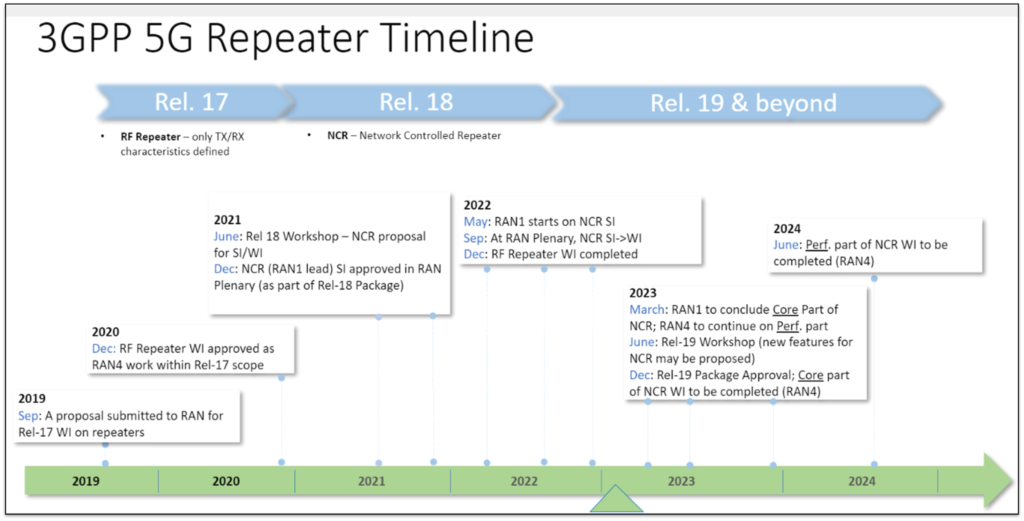Repeaters and 3GPP
By Andjela Ilic-Savoia, Technical Engagement Manager, 3GPP Delegate
This blog entry will describe the evolution of 5G repeaters within 3GPP (3rd Generation Partnership Project). 3GPP is an engineering consortium that develops technical specifications for the telecommunications industry. These technical specifications are then transposed into standards by standards organizations. Without global interoperability standards, wireless devices would not connect reliably. As the father of 5G repeaters and a 3GPP member, Pivotal Commware has made important contributions to repeater specifications.
5G Repeaters Get Respect
The first 5G specification, Release 15, was finalized in 2017 and only defined devices (like smartphones or CPEs) and base stations. Repeaters didn’t appear until 2020, under the scope of Release 17[1] — and Release 17 work was not completed until 2022.
Years before 3GPP included repeaters as an item of interest, Pivotal identified a market need for extending base station coverage. To improve coverage, network operators could either deploy more base stations or deploy repeaters. Pivotal’s unique repeater advantage comes from Holographic Beam Forming® antenna technology, which offers the lowest cost, size, weight, and power-consumption. The Pivot 5G® outdoor network repeater was commercially released in early 2021.

Pivot 5G is now part of a product ecosystem that includes the WaveScape™ network planning tool, Echo 5G® subscriber repeater for in-building penetration, Intelligent Beam Management System (IBMS) for network management and optimization, and Pivotal Turnkey™ Service, an end-to-end solution that uses these products to plan and deploy 5G networks on behalf of Mobile Network Operators.
While Pivot 5G development was underway, so was Release 17, which included the RF Repeater typified by Pivot 5G. Pivotal contributed to this specification effort, which concluded in December 2022. Before the conclusion of Release 17, 3GPP began specifying Release 18, which featured another type of repeater, Network Controlled Repeater (NCR). What’s the difference between NCR and the RF Repeater like the Pivot?
Two Repeater Types
As its name implies, an NCR is controlled by the base station, much like a mobile device is controlled by a base station (and the core network it connects to). NCR is envisioned as a “preferred observer” and an extension of the base station, acting on its behalf to improve coverage and service for end-users. The idea is that base stations tell NCRs what to do, and when to do it, at a minimum. This way, an NCR would expand its understanding of 5G network and over-the-air (OTA) messages. Specifically, an NCR should:
- Be transparent to the mobile devices it serves.
- Use beamforming information, or beamform itself, to user equipment.
- Use timing information to align its transmission and reception boundaries.
- Manage interference and control energy consumption.
- Obey 3GPP standardized procedures for authentication and authorization.
By contrast, Pivot 5G performs amplify-and-forward in downlink and in uplink directions simultaneously, it uses cloud-based IBMS for efficient remote management and control, and it has intelligence to act autonomously to adapt to changes in the network conditions, environments, etc. Additionally, Pivots do not decode 5G OTA messages. This makes them superfast, and less expensive than NCRs will be after they’re completely specified by 3GPP in 2024 and eventually manufactured.
Conclusion
Based on its market leadership and deployment experience, Pivotal will offer both products to carriers as their use cases warrant. NCRs will provide a measure of base station control, at greater cost and complexity. RF Repeaters offer less complexity, simpler integration, and lower cost.
[1] Release 16 introduced Integrated Access and Backhaul (IAB), a dual personality network node acting on one side as base station, towards user equipment, and on another as a device, towards the base station. IAB as a proof-of-concept has been tested by some network operators, but IAB products have never been commercialized.

